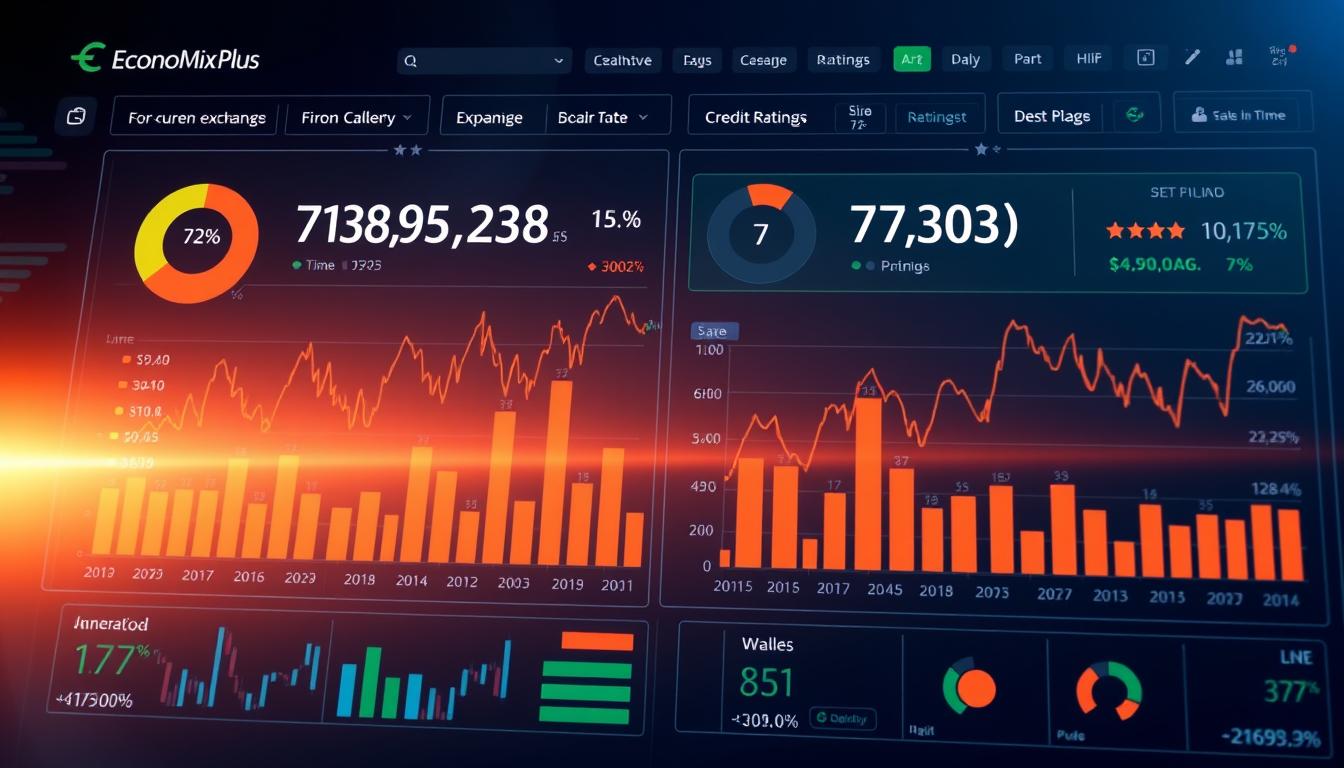Have you ever wondered why some nations thrive in global trade while others struggle? The answer often lies in their credit rating, a critical factor shaping international commerce. Sovereign credit ratings serve as a financial report card, influencing a country’s ability to secure funding for imports and exports.
These ratings act as risk indicators for global investors. A high rating signals stability, attracting foreign investments and lowering trade costs. Conversely, a low rating can increase borrowing expenses and weaken currency values, making trade more challenging.
Both developed and developing nations closely monitor their credit ratings. Changes in these ratings can reshape economic partnerships and alter trade dynamics. Understanding this relationship is essential for grasping the complexities of global commerce.
Key Takeaways
- Sovereign credit ratings influence a nation’s ability to finance trade activities.
- High ratings attract foreign investments and reduce trade costs.
- Low ratings can increase borrowing expenses and weaken currency values.
- Credit ratings serve as risk indicators for global investors.
- Both developed and developing nations monitor these ratings closely.
Understanding Credit Ratings and Their Importance
The financial health of a country is often measured by its sovereign credit rating. These ratings are independent evaluations of a nation’s creditworthiness, conducted by major rating agencies like Standard & Poor’s, Moody’s, and Fitch. They assess economic and political risks to determine how likely a country is to meet its financial obligations.
Each agency uses a unique scale to assign ratings. For example, Standard & Poor’s ranges from AAA (highest) to D (default). Ratings above BBB- are considered investment grade, while those below are labeled speculative or “junk.” These distinctions significantly impact a nation’s ability to secure international financing.
What Is a Sovereign Credit Rating?
A sovereign credit rating evaluates a country’s ability to repay its debts. It reflects factors like economic stability, political environment, and fiscal policies. For instance, in 2023, Fitch downgraded the United States to AA+ due to governance issues and debt ceiling risks. This decision highlighted the importance of maintaining strong financial practices.
Why Credit Ratings Matter for Countries
Credit ratings are crucial for accessing global funding. Nations with high ratings, like Germany and Singapore, enjoy lower borrowing costs and attract foreign investment. Conversely, lower ratings can lead to higher interest rates and reduced investor confidence. For example, countries with speculative ratings often face challenges in financing trade and development projects.
Top-rated nations, such as Australia, Canada, and Switzerland, benefit from favorable trade conditions. Their strong ratings signal stability, making them attractive partners in international commerce. Understanding these dynamics is essential for navigating the complexities of global finance.
How Credit Ratings Influence International Trade
Global trade dynamics are deeply influenced by a nation’s financial reputation and credit rating agencies. A strong financial standing may impact listings and opens doors to better trade opportunities, while a weak one can create significant barriers. This relationship is particularly evident in the mechanisms of trade financing and the costs associated with moving goods across borders, which may impact interest rates and compensation may affect partnerships.
The Role of Credit Ratings in Trade Financing
Financial reputation plays a critical role in securing trade financing. Banks and other financial institutions rely on creditworthiness to assess the risk of providing funds. For example, letters of credit and trade insurance premiums are directly affected by a country’s financial standing.
Developing nations face a $1.3 trillion global trade finance gap. This disparity is especially challenging for small and medium-sized enterprises (SMEs). While multinational corporations see only 7% of their financing requests rejected, SMEs in developing countries face rejection rates as high as 50%.
Initiatives like the Commonwealth Trade Finance Facility aim to address these challenges. By providing guarantees, they help SMEs access the funds needed to participate in global trade. However, countries with poor financial reputations often require higher collateral, making it harder for exporters to compete.
Impact on Import and Export Costs
Financial reputation also affects the costs of importing and exporting goods. A downgrade in financial standing can lead to currency depreciation, increasing the cost of imports. For instance, Argentina’s CC rating in 2023 contributed to rising import inflation, making foreign goods more expensive.
In contrast, countries with strong financial reputations, like Chile with its A- rating, enjoy more stable currency values. This stability reduces the cost of trade and makes their export goods more competitive on the global market.
Understanding these dynamics is essential for businesses and policymakers. By addressing financial challenges, nations can improve their trade prospects and strengthen their positions in the global economy.
Factors That Shape a Country’s Credit Rating
The backbone of a nation’s financial reputation lies in its ability to manage key economic factors, including those that credit rating agencies assess. These elements not only determine its financial health but also influence its trade competitiveness on the global stage, impacting listings that appear in financial analyses. Two primary areas—economic stability and fiscal policies—play a decisive role in shaping this reputation.

Economic Stability and Political Environment
A stable economy and political environment are critical for maintaining a strong financial standing. For instance, the Eurozone crisis highlighted how political instability and loss of currency sovereignty can lead to downgrades. Countries like Greece saw their ratings drop significantly, while Germany maintained its AAA status due to robust economic management.
Moody’s rating criteria emphasize GDP growth, political stability, and policy effectiveness. Nations with consistent growth and low risk factors, such as Singapore, often enjoy higher ratings. Anti-corruption measures in Singapore have also contributed to its strong financial reputation.
Debt Levels and Fiscal Policies
Debt management is another crucial factor. Japan, despite its high debt-to-GDP ratio, maintains a stable rating due to its prudent fiscal policies. In contrast, Venezuela’s defaults underscore the dangers of poor fiscal management.
Excessive growth in money supply can also trigger downgrades by increasing inflation risks. Norway’s sovereign wealth fund is an example of effective fiscal policy, ensuring long-term stability. Countries must adhere to international standards to avoid negative impacts on their financial reputation.
Understanding these factors is essential for nations aiming to improve their trade prospects. By addressing economic and fiscal challenges, they can strengthen their positions in the global economy. For more insights, explore how foreign investments are influenced by financial reputation.
The Connection Between Credit Ratings and Currency Exchange Rates
Currency exchange rates and financial reputation are deeply intertwined in global trade. A nation’s ability to maintain stable currency values often reflects its financial health and credit rating. Changes in financial standing, such as those influenced by interest rates, can lead to significant shifts in exchange rates, impacting trade dynamics and economic competitiveness. Additionally, as seen in various reports from Investopedia, partnerships and offers available in the marketplace can further illustrate how these factors interact.

Research by Fitch highlights that a 20% variance in currency value can result from shifts in financial reputation. For example, upgrades from AA+ to AAA often strengthen a currency’s purchasing power. This stability attracts foreign investment and reduces borrowing costs, creating a positive cycle for trade.
How Financial Reputation Affects Currency Value
A strong financial reputation signals stability, boosting confidence in a nation’s currency. Countries with high ratings, like Switzerland, enjoy stable exchange rates. In contrast, downgrades can lead to currency depreciation, as seen with Nigeria’s naira after its 2020 downgrade.
Exchange rate volatility often correlates with financial health. For instance, the Turkish Lira has faced significant fluctuations due to economic instability. In contrast, the Swiss Franc remains a safe haven, reflecting Switzerland’s robust financial management.
Exchange Rates and Their Impact on Trade
Exchange rates directly influence the cost of goods services in international trade. A strong currency, like the US dollar, can increase export prices by up to 15%, as noted by the IMF in 2022. This makes exports less competitive but reduces import costs.
Conversely, a weaker currency can boost exports. A 10% devaluation often leads to a 25% surge in export volumes. However, it also escalates import costs, impacting domestic industries reliant on foreign inputs.
- Strong currencies deter tourism, as seen with the Eurozone’s strong euro reducing US visitors.
- Weak currencies attract foreign buyers but increase inflation risks.
- Exchange rate stability is crucial for long-term trade partnerships.
Understanding these dynamics helps nations navigate trade challenges and strengthen their economic positions.
Case Studies: Credit Ratings and Trade Outcomes
Real-world examples reveal how financial reputations shape trade outcomes. Nations with strong financial health often dominate global trade, while those with weaker standings face significant challenges. This section explores the impact of financial reputations through case studies and lessons from historical events, including offers available and the impact listings appear on trade dynamics.

Examples of Nations with High and Low Financial Standing
Denmark, with its AAA rating, maintains a 30% trade surplus, particularly in agricultural exports. This success highlights how strong financial reputations attract table partnerships investopedia and boost trade competitiveness. In contrast, Pakistan’s textile industry struggles due to its lower financial standing, limiting its export potential.
Iceland’s recovery post-2008 crisis is another compelling example. After a downgrade, its fishing exports surged, demonstrating how strategic adjustments can mitigate financial challenges. Similarly, Vietnam’s upgrade trajectory within ASEAN trade pacts showcases the benefits of improving financial reputations.
Lessons from the Eurozone Debt Crisis
The Eurozone crisis underscored the link between financial stability and trade. Germany’s machinery exports thrived due to its strong financial reputation, while Greece’s olive oil pricing struggled post-crisis. However, Greek exports grew by 18% after euro depreciation, illustrating how currency adjustments can aid recovery.
- Denmark’s agricultural exports contrast sharply with Pakistan’s textile struggles.
- Iceland’s fishing exports rebounded post-downgrade, showcasing resilience.
- Eurozone export shifts highlight the importance of financial stability.
- Vietnam’s upgrade trajectory within ASEAN trade pacts demonstrates growth potential.
- BRICS New Development Bank faces challenges in maintaining financial reputations.
- India’s SME export growth increased by 22% through association models.
These case studies emphasize the critical role of financial reputations in shaping trade outcomes. By addressing financial challenges, nations can improve their global trade positions and foster economic growth.
How Countries Can Improve Their Credit Ratings
Improving financial standing is a priority for nations aiming to boost their global trade presence. Strong financial health attracts foreign investments, reduces borrowing costs, and enhances trade competitiveness. This section explores strategies for economic reform and the role of international partnerships in achieving these goals.
Strategies for Economic and Fiscal Reform
Economic stability and prudent fiscal policies are essential for improving financial standing. Rwanda’s 7% GDP growth through Commonwealth partnerships demonstrates the impact of strategic alliances. Similarly, Chile’s copper export stabilization fund model has ensured economic resilience.
Botswana’s diamond revenue management system led to an S&P upgrade in 2021. Ghana’s VAT reforms resulted in a 2-notch upgrade, showcasing the effectiveness of fiscal discipline. Digital transformation, like Estonia’s e-residency program, has also boosted trade by streamlining processes.
The Role of International Partnerships
International collaborations play a crucial role in enhancing financial health. The ASEAN Currency Swap Arrangements provide liquidity support during crises. Kenya’s digital SME credit scoring pilots have improved access to trade financing, aligning with global standards.
Blockchain solutions are emerging as a game-changer for trade documentation transparency. These innovations reduce risks and improve efficiency, making them attractive to global investors. By leveraging such technologies, nations can strengthen their financial reputations.
| Strategy | Example | Impact |
|---|---|---|
| Fiscal Reforms | Ghana’s VAT reforms | 2-notch upgrade |
| Digital Transformation | Estonia’s e-residency | Trade boosts |
| International Partnerships | ASEAN Currency Swap | Liquidity support |
| Resource Management | Botswana’s diamond fund | S&P upgrade |
By implementing these strategies, nations can improve their financial standing and enhance their global trade prospects. Investopedia receives compensation for highlighting such success stories, offering valuable insights for policymakers and businesses alike.
Conclusion
The relationship between financial health and global commerce is undeniable. A country’s ability to attract investment and facilitate trade hinges on its financial reputation. Rating agencies now evaluate digital economies, signaling a shift in criteria.
AI-driven models are poised to reshape trade finance, potentially influencing sovereign ratings. However, protectionism poses risks, threatening global partnerships and financial stability. Policymakers must prioritize transparency reforms to mitigate these challenges.
The bottom line is clear: financial health drives trade success. With 74% of trade disputes involving rated nations, maintaining a strong financial reputation is essential. The bottom line for global commerce lies in fostering trust and stability.














